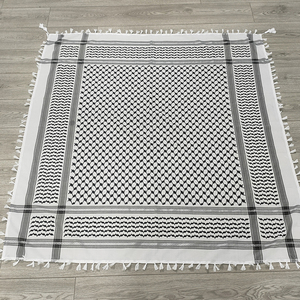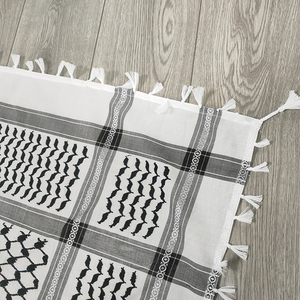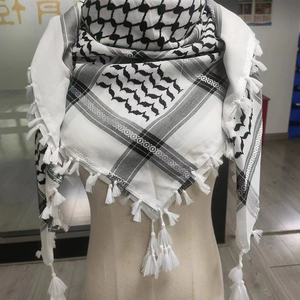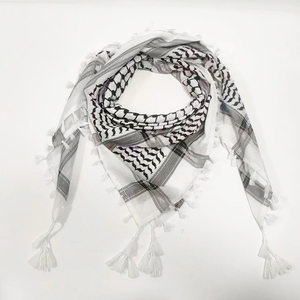
All categories
Featured selections
Trade Assurance
Buyer Central
Help Center
Get the app
Become a supplier

(3376 products available)

















































Arab men’s scarves, commonly known as ghutras or shemags, come in different varieties depending on the cultural background and personal preference of the wearer. Here are some of their major types:
Ghutra
The white scarf worn by the Arabs is called the Ghutra. It is also referred to as the Kufiya or the Safa. It serves as a symbol of honor and dignity in the Arab world. The Ghutra, which is normally white, is mostly worn in Saudi Arabia and some other Gulf countries. While the Saudi Arabian Ghutra is rectangular, the Kuwaiti version is square. Nonetheless, both types are usually plain white, though they may be interspersed with different colors of borders or patterns.
Shemag
The shemag is a traditional Middle Eastern scarf that is mostly patterned with checks. It is also known as the keffiyeh or the ghutrah in various cultures. The shemag has become one of the most popular scarves because of its versatility and ability to provide warmth and protection from the sun. It is usually worn on the head but can also be wrapped around the neck or shoulders. The shemag is mainly produced in Palestine, Jordan, and Egypt, and its designs vary from one region to another. While some have large check patterns, others have small ones. The colors are equally diverse, with white and black or red and white being the most common color combinations.
Kufiya
The Kufiya is a traditional Palestinian Arab men's scarf that is usually woven from cotton. It is mostly patterned with checks and comes in various colors, with black and white or red and white being the most common. The Kufiya is an important cultural symbol for the Palestinians. It is worn as a head covering to shield the face from the sun and wind. The Kufiya is also a national symbol of Palestine and is often used as a sign of solidarity with the Palestinian people.
Safa
The Safa is a variation of the ghutrah and is predominantly worn by men in the Arabian Peninsula. It is mostly white but may have colored borders or patterns. The Safa is usually worn in a more formal or traditional setting and is often associated with cultural and religious practices. It is commonly worn during special occasions, ceremonies, and religious events.
Ghutra with Agal
A ghutra worn with an agal is a traditional Arab headwear combination. It consists of a black cord called the agal, which is used to secure the ghutra in place. The agal is usually worn on top of the ghutra, and it helps keep the scarf in position, especially in windy conditions. This combination is commonly seen in Gulf countries like Saudi Arabia, the United Arab Emirates, and Qatar, where it is a symbol of cultural identity and tradition.
Arab men’s scarves have different designs based on their use and the region in which they are used. Their design elements include the following:
Patterns
Arab headscarves feature patterns that provide cultural identity and style. The patterns are usually woven into the fabric rather than printed on the surface. The patterns of the keffiyeh include checkered patterns, striped patterns, and geometric patterns. The checkered pattern is the most common. It has varying sizes, with the small squares being more common than the big squares. They are usually in black and white or red and white colors. The checkered pattern is used in Palestine, Jordan, and some parts of the Gulf region. Striped patterns consist of stripes of varying widths and orientations. They can be horizontal, vertical, or diagonal. Geometric patterns are more complex than the other two and contain shapes like diamonds, hexagons, and spirals.
Colors
The Arab men's scarf colors vary with culture, occasion, and personal preference. The most common colors are black, white, red, and brown. Black and white scarves are usually worn in Palestine and some parts of the Gulf region. The red and white scarves are more common in Jordan, while the brown ones are considered neutral and are worn for different occasions. Other colors like blue, green, and yellow are also used. Blue and green scarves are worn for formal occasions, while the yellow ones are more for fashion statements.
Fringes and Borders
Arab scarves have fringes and borders that add to their aesthetic appeal and functionality. Fringes are threads that are left loose at the ends of the scarf. They help prevent the fabric from fraying. Borders are ornamental designs along the edges of the scarf. They may be embroidered, woven, or printed. Both fringes and borders have cultural significance and vary with region and tradition. For instance, the keffiyeh has a fringe known as 'selvedge,' while the ghutrah has hemmed edges without fringes. In addition, the keffiyeh's border patterns are often more complex than those of the ghutrah.
Fabric
Arab men’s scarves are made from different fabrics, and each type has its advantages. Cotton is the most common fabric because it is affordable, and the scarves made from it are light and easy to use. Wool is used for making scarves that offer more warmth. Silk and synthetic fibers like polyester are used in high-end scarves. Silk makes a soft, shiny scarf with an elegant look and feel. Polyester, on the other hand, is used in many scarves because it is affordable and the scarves made from it are light and easy to use.
Here are some tips on wearing and matching Arab men's scarves, highlighting their cultural significance and practical applications:
Wearing suggestions:
Wearing an Arab men's scarf, known as a ghutrah, keffiyeh, or shemagh, involves a few simple steps. First, place the scarf on the head with one side slightly longer than the other. Second, wrap the longer side around the back of the neck and bring it over the opposite shoulder. Third, take the remaining part of the scarf and drape it over the head, adjusting it for comfort and coverage. Finally, secure the scarf in place by tucking the ends into the folds or using a scarf clip. This style provides protection from the sun and sand and cultural representation in many Arab countries.
Matching suggestions:
Matching an Arab men's scarf with different outfits can enhance both style and cultural authenticity. For traditional attire, such as the dishdasha or kandura, a white or red-and-white checked scarf complements the look and signifies cultural identity. In casual settings, pairing a black and white keffiyeh scarf with a plain t-shirt and jeans creates a laid-back, trendy appearance. Opt for neutral-colored or subtle patterns if one wants to integrate the scarf into a more formal ensemble. The scarf's classic colors and patterns can add a sophisticated touch without overwhelming the overall outfit. Experimenting with different draping styles and accessories, like sunglasses or a baseball cap, can also personalize the look while respecting the scarf's cultural significance.
Q1: Why do Arab men wear scarves?
A1: Arab men wear scarves for cultural, religious, and practical reasons. Traditionally, they are a symbol of Arab identity and heritage. They provide protection from the sun, wind, and sand in desert environments. Religiously, they can signify modesty and respect. The scarf, or head covering, is an integral part of daily attire, reflecting both practical needs and cultural traditions.
Q2: What are the benefits of wearing a scarf for men?
A2: Wearing a scarf offers several benefits for men. It provides protection from environmental elements like sun, wind, and cold. In hot weather, it helps absorb sweat and keeps the body cooler. Scarves also serve as a stylish accessory, adding to an outfit and providing warmth in cooler conditions. They can be made from various materials, offering versatility for different climates and occasions.
Q3: What is the significance of the keffiyeh pattern?
A3: The keffiyeh patterns hold cultural and regional significance. Different patterns can indicate the wearer's tribal or regional affiliation. For example, the black and white checked pattern is commonly associated with Palestine, while the red and white pattern is associated with Bedouin culture. Each pattern can carry historical and social meanings, reflecting the rich tapestry of Arab heritage and identity.
Q4: How do men keep their scarves on their heads?
A4: Men keep scarves on their heads using various methods, often involving folding the scarf into a triangle, placing it on the head, and securing it with an under or behind the chin. Some may use additional ties or clips for security, especially in windy conditions. The specific technique can vary based on the type of scarf and personal preference, ensuring it stays in place throughout the day.
Q5: Are Arab men's scarves a religious requirement?
A5: While Arab men's scarves are not universally a religious requirement, they can have religious significance in Islam. Wearing a headscarf can be a sign of respect and adherence to cultural norms in many Muslim communities. However, the necessity and style of head coverings can vary widely, depending on personal beliefs, cultural practices, and the specific social context within different Arab countries and regions.